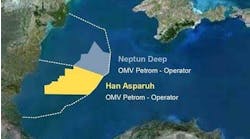DRILLING TECHNOLOGY Micro-annulus under-balanced drilling of multilateral wells
Process preserves reservoir during drilling and completion
Robert A. Gardes
Gardes Energy Services
Under-balanced drilling of multilateral wells represents a significant technological advancement over conventional horizontal drilling technology, in terms of minimal environmental impact, improved drilling efficiency, maximum production enhancement due to gravity drainage and areal sweep, the potential to recover a greater percentage of reserves in place especially in pressure depleted and/or fractured reservoirs, and reduced drilling and operating costs.
Combining the technologies of horizontal/multilateral underbalanced drilling gives operators the means of improving production rates and increasing the percentage of hydrocarbons through greater formation exposure and better reservoir drainage. Overall costs are reduced due to increased rates of penetration, elimination of lost circulation, reduction of stuck pipe, and increased bit life.
Contact with both horizontal and vertical fractures and gravity drainage allows maximum recovery of oil in place, even in pressure depleted reservoirs. This system can be fitted for use with all aspects of enhanced oil recovery. The production of the entire system is generated from a single pump and is applicable to both inland and offshore operations.
This multilateral technology penetrates the reservoir in a number of places with radially offset well bores all along its length. This is achieved through the use of a patented two-string micro-annulus drilling technique, together with the Gardes Energy's upstock.
The upstock can be oriented and activated as often as required along the horizontal length to allow for numerous radials without the need to withdraw it from the well bore, thereby maintaining an under-balanced condition for greater than 90% during the drilling and completion phases.
Benefits
The union of under-balanced drilling and multilateral drilling technologies to develop new or enhance existing reservoirs has gained a great deal of attention. A new rationalization for multilateral horizontal wells is the reduction of the economic risk associated with poor reservoir characterization in aureole anisotropy formations while increasing the incremental net present value (NPV) over single horizontal wells.
Combined with under-balanced drilling and completion, multilateral horizontal wells are able to protect the producing formations from damaging effects associated with fluids lost while drilling and completing. This also eliminates excessive losses of expensive drilling and completion fluids.
In traditional multilateral drilling, what often happens is that the formation clays, which are incompatible with drilling/completion fluids, will swell and effectively reduce permeability.
Other types of formation damage consistent with conventional drilling and completion methods
include:
- Emulsification of drilling fluids with formation fluids
- Precipitation of solids
- Reduction of relative permeability to gas by the presence of a third immiscible fluid
- Reduction of relative permeability to oil due to increased irreducible water saturation.
Under-balanced drilling, when properly designed and executed, minimizes or eliminates
problems associated with the invasion of particulate matter into the formation. Invasion damages often greatly reduce the productivity of reservoirs, particularly in open hole horizontal well applications. Under-balanced drilling can also minimize numerous other problems, such as adverse clay reactions, phase trapping, precipitation, and emulsification, These problems can he caused by the invasion of incompatible mud filtrates in an overbalanced condition. The system overcomes these problems and allows maximum productivity.
System components
Gardes Energy's patented system and method increases horizontal drilling technology's ability to address formation damage and solves the problems encountered in previous under-balanced drilling systems.
What is provided is a system for drilling radial wells from a single vertical or horizontal well, using an under-balanced drilling technique. This under-balanced drilling technique enables the under-balanced condition to be implemented during both drilling and completion phases.
This procedure provides a first outer casing lining the welfare, A second inner casing, called a carrier string, is used as a second inner string. Then, either coiled tubing or regular drill pipe is used as the inner drill string. A whipstock or upstock is attached to the carrier string and lowered into the cased or uncased well bore.
The carrier string is then lowered into the outer casing, hung off in either the wellhead or rotary table. Then the drilling assembly is lowered into the carrier string and oriented in the direction of the previously oriented upstock. When the drill bit makes contact with the deflecting surface or the whipstock or upstock, there is a bore drilled through the wall of the casing or into the open hole, depending on the type of casing material used or the type of wellbore to be drilled.
An orientation sub is attached to the motor assembly on the coiled tubing assembly, so that both the upstock and the coiled tubing drilling assembly may be oriented in the proper orientation when the radials are drilled through the walls of the casing.
In the process of under-balanced drilling, the first fluid is circulated down the annulus of the coiled tubing. This fluid can be air, nitrogen, and drilling fluid. This fluid drives the mud motor assembly and rotates the drill bit. Simultaneously, a second and different fluid, such as aerated nitrogen and drilling fluid in a combination not to cause damage to the formation, is circulated down the annulus between the carrier string and the inner drill string.
The two fluids commingle at the exit point of the inner drill string and the upstock and are returned as commingled fluid in the annular space between the carrier string and the casing of the borehole. This commingled fluid is then returned to the separator above the Hydril. This allows for the hydrostatic pressure to be controlled through both drilling and completion phases.
As the drill bit is retrieved from a radial well, a kill slug is pumped down the annulus between the carrier string and the drill string.
The kill slug is comprised of fluids in a weight ratio to displace the pipe so that the hydrostatic pressure in the carrier string will not allow the fluid to flow up the carrier string while the drill string is retrieved through it. The well remains live on the outer casing annulus and is controlled by the weight of the fluid being pumped down the carrier string. The well is essentially being drilled as a live well within the main well bore. The carrier string with the upstock on its end is repositioned at a different point in the borehole, while the well is alive.
The coiled tubing is re-lowered into the borehole to drill the next radial. The drilling of additional radials and various orientations is accomplished while the well is maintained as a live well as long as the fluid pressure is under-balanced within the well bore through a combination of fluid in the drill string and carrier string.
Although there are many different types of under-balanced drilling, the most effective and the real key to successful under-balanced drilling, is to remain in an under-balanced condition 100% of the time through the drilling and completion process. The system described here does this with the use of a micro-annulus under-balanced technique.
Completion
Under-balanced completion of wells is an inherent continuation of under-balanced drilling. It provides several benefits, including reduced fluid loss, improved productivity, and minimized formation damage.
The primary purpose for drilling a well under-balanced is defeated if the well is suspended and completed in the overbalanced state. By completing the well under-balanced, formation damage and loss of expensive fluids are prevented and productivity is maximized.
Under-balanced completions are usually performed using coiled tubing. Being a continuation of coiled tubing under-balanced drilling, it is necessary to retain long bottomhole assemblies such as screens, liners and perforation guns in an under-balanced state.
There are presently three types of completions used in conventional drilling - open hole, cased hole, and slotted liner completions. Open hole or barefoot completions are currently used in most under-balanced completions.
In open hole completions, casing is set and cemented immediately above the anticipated producing horizon. Then, the well is drilled to total depth and completed open hole. Being economical and simple to perform, most horizontal wells are completed with this method. The disadvantage of this type of completion is that it leaves the reservoir susceptible to damage from reduced relative permeability due to excessive fluid loss. Additional disadvantages to open hole completions are well bore collapse or production of unwanted gas or water.
By eliminating the restraint in wellbore stability, cased hole completions offer a greater benefit than open-hole completions. Other advantages to cased hole completions are being able to maintain a controllable well and to isolate productive zones. The major drawback to cased hole completions is also well control. While running casing, the kill weight fluid must be used so that the well will not flow.
Slotted liner completions are an expansion of an open hole completion which uses a slotted liner. While borehole stability is improved, slotted liner completions are deficient in well control as are open hole completions.
All of the above completion concepts are performed in an overbalanced condition where the hydrostatic column of fluid is greater than the formation pressure. While this does not present a problem in most wells, there are areas or formations where destruction of the formation occurs or where there are critical losses of expensive drilling and completion fluids. Under-balanced drilling and the new technologies available today may eliminate many of these problems if we can change the prejudice of traditional methods.
Horizontal, multilateral, and under-balanced drilling are technologies still in their infancies. Their futures are certain. They will continue to flourish and proliferate in the industry because they meet the criteria essential to developing the huge resource deemed unrecoverable with conventional methods.
REFERENCES
Smith, J., Economides, M., "Reducing Economic Risk in Areally Anisotropic Formations
with Multiple-Lateral Horizontal Wells," SPE 30647, Annual Conference, Dallas, October, 1995.
Bennion, D., "Under-balanced operations offer pluses and minuses," Oil & Gas Journal,
January 1, 1996.
Walker, T., "Under-Balanced Completions," SPE 30648, Annual Conference, Dallas, October, 1994.
Bennion, D. B., Thomas, F., Bietz, R., Bennion, D.W., "Recent Studies of Formation Damage in Horizontal Wells, Under-balanced and Overbalanced Conditions - An Update," PNEC Conference on Horizontal Well & Emerging Technologies, Houston, November, 1995.
Copyright 1996 Offshore. All Rights Reserved.


